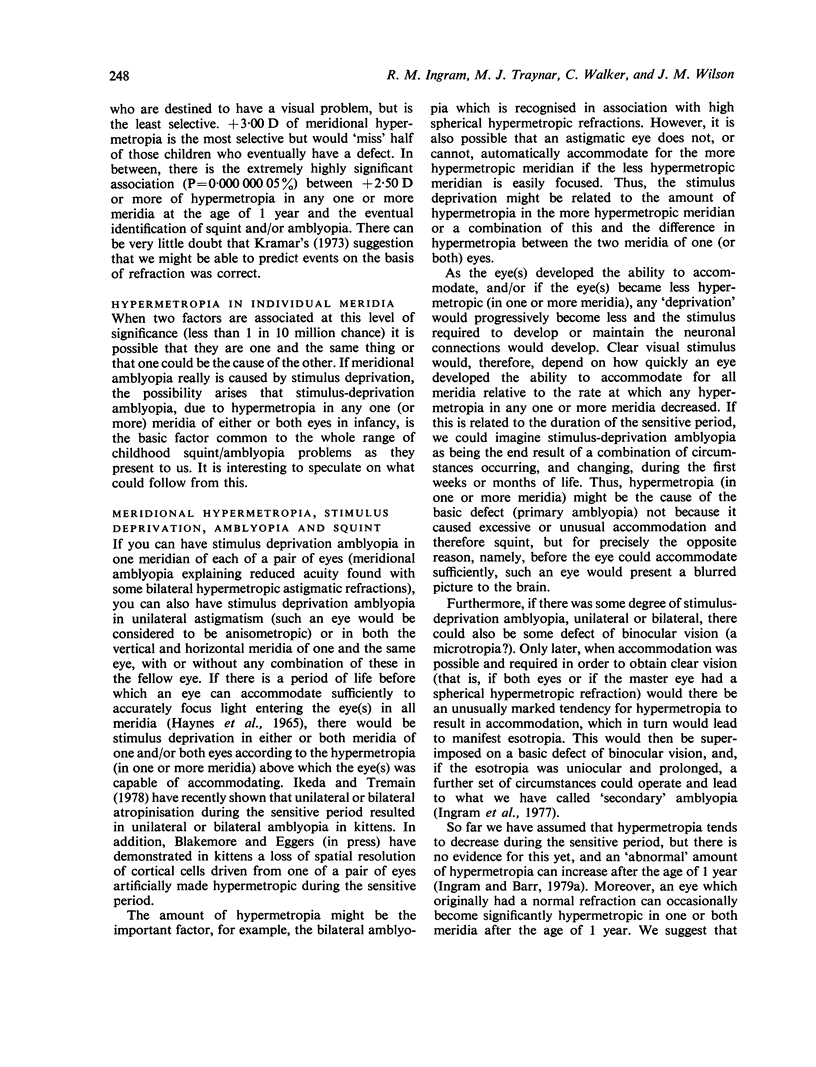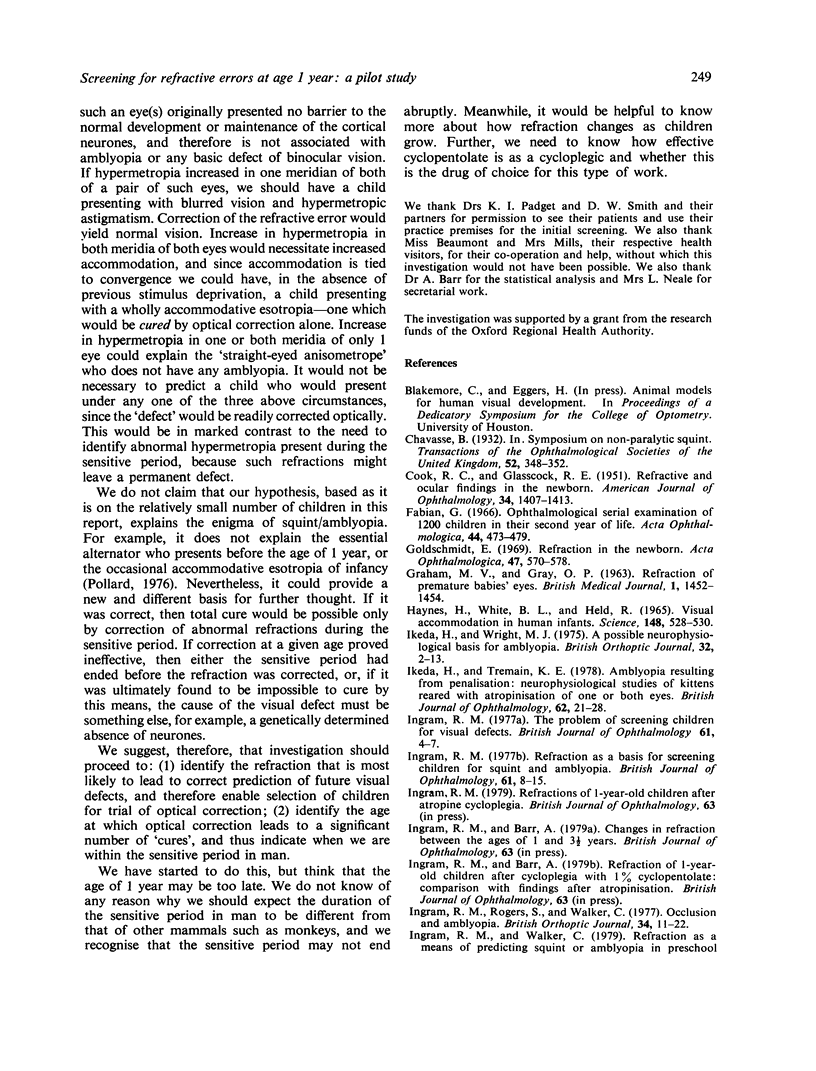Abstract
Cycloplegic refraction of 1-year-old children is technically possible and is acceptable to mothers as a method for screening children for visual defects. The range of refractions found in a sample of 186 1-year-old children is reported. Prediction of which children are significantly at risk for squint and/or amblyopia is possible on the basis of refractions at age 1 year according to the criteria selected for an 'abnormal' refraction. Bilateral hypermetropia and/or astigmatism or anisometropia at age 1 year was significantly (P less than 1 in 10 000) associated with a child eventually being found to have squint or amblyopia. Both the age of screening and criteria of abnormality will probably need modification. +2.50 or more D hypermetropia in any one meridian of either eye at age 1 year was even more significantly (P = 0.000 000 05%) associated with squint and/or amblyopia. The possibility that meridional hypermetropia could be the basic defect in squint and amblyopia is discussed.
Full text
PDF







Selected References
These references are in PubMed. This may not be the complete list of references from this article.
- COOK R. C., GLASSCOCK R. E. Refractive and ocular findings in the newborn. Am J Ophthalmol. 1951 Oct;34(10):1407–1413. doi: 10.1016/0002-9394(51)90481-3. [DOI] [PubMed] [Google Scholar]
- Fabian G. Augenärztliche Reihenuntersuchung von 1200 Kindern im 2. Lebensjahr. Acta Ophthalmol (Copenh) 1966;44(3):473–479. doi: 10.1111/j.1755-3768.1966.tb08061.x. [DOI] [PubMed] [Google Scholar]
- GRAHAM M. V., GRAY O. P. Refraction of premature babies' eyes. Br Med J. 1963 Jun 1;1(5343):1452–1454. doi: 10.1136/bmj.1.5343.1452. [DOI] [PMC free article] [PubMed] [Google Scholar]
- Goldschmidt E. Refraction in the newborn. Acta Ophthalmol (Copenh) 1969;47(3):570–578. doi: 10.1111/j.1755-3768.1969.tb08143.x. [DOI] [PubMed] [Google Scholar]
- HAYNES H., WHITE B. L., HELD R. VISUAL ACCOMMODATION IN HUMAN INFANTS. Science. 1965 Apr 23;148(3669):528–530. doi: 10.1126/science.148.3669.528. [DOI] [PubMed] [Google Scholar]
- Ikeda H., Tremain K. E. Amblyopia resulting from penalisation: neurophysiological studies of kittens reared with atropinisation of one or both eyes. Br J Ophthalmol. 1978 Jan;62(1):21–28. doi: 10.1136/bjo.62.1.21. [DOI] [PMC free article] [PubMed] [Google Scholar]
- Ingram R. M. Refraction as a basis for screening children for squint and amblyopia. Br J Ophthalmol. 1977 Jan;61(1):8–15. doi: 10.1136/bjo.61.1.8. [DOI] [PMC free article] [PubMed] [Google Scholar]
- Ingram R. M. The problem of screening children for visual defects. Br J Ophthalmol. 1977 Jan;61(1):4–7. doi: 10.1136/bjo.61.1.4. [DOI] [PMC free article] [PubMed] [Google Scholar]
- Ingram R. M., Walker C. Refraction as a means of predicting squint or amblyopia in preschool siblings of children known to have these defects. Br J Ophthalmol. 1979 Apr;63(4):238–242. doi: 10.1136/bjo.63.4.238. [DOI] [PMC free article] [PubMed] [Google Scholar]
- Kubistová V. Príspevek ke genezi anizometropie. Cesk Oftalmol. 1968 Jul;24(4):263–265. [PubMed] [Google Scholar]
- Lukaszewicz B. Badania refrakcji do 3 roku zycia. Klin Oczna. 1972;42(3):833–835. [PubMed] [Google Scholar]
- Mitchell D. E., Freeman R. D., Millodot M., Haegerstrom G. Meridional amblyopia: evidence for modification of the human visual system by early visual experience. Vision Res. 1973 Mar;13(3):535–558. doi: 10.1016/0042-6989(73)90023-0. [DOI] [PubMed] [Google Scholar]
- Pollard Z. F. Accommodative esotropia during the first year of life. Arch Ophthalmol. 1976 Nov;94(11):1912–1913. doi: 10.1001/archopht.1976.03910040622009. [DOI] [PubMed] [Google Scholar]
- Von Noorden G. K. Factors involved in the production of amblyopia. Br J Ophthalmol. 1974 Mar;58(3):158–164. doi: 10.1136/bjo.58.3.158. [DOI] [PMC free article] [PubMed] [Google Scholar]
- Wiesel T. N., Hubel D. H. Ordered arrangement of orientation columns in monkeys lacking visual experience. J Comp Neurol. 1974 Dec 1;158(3):307–318. doi: 10.1002/cne.901580306. [DOI] [PubMed] [Google Scholar]


